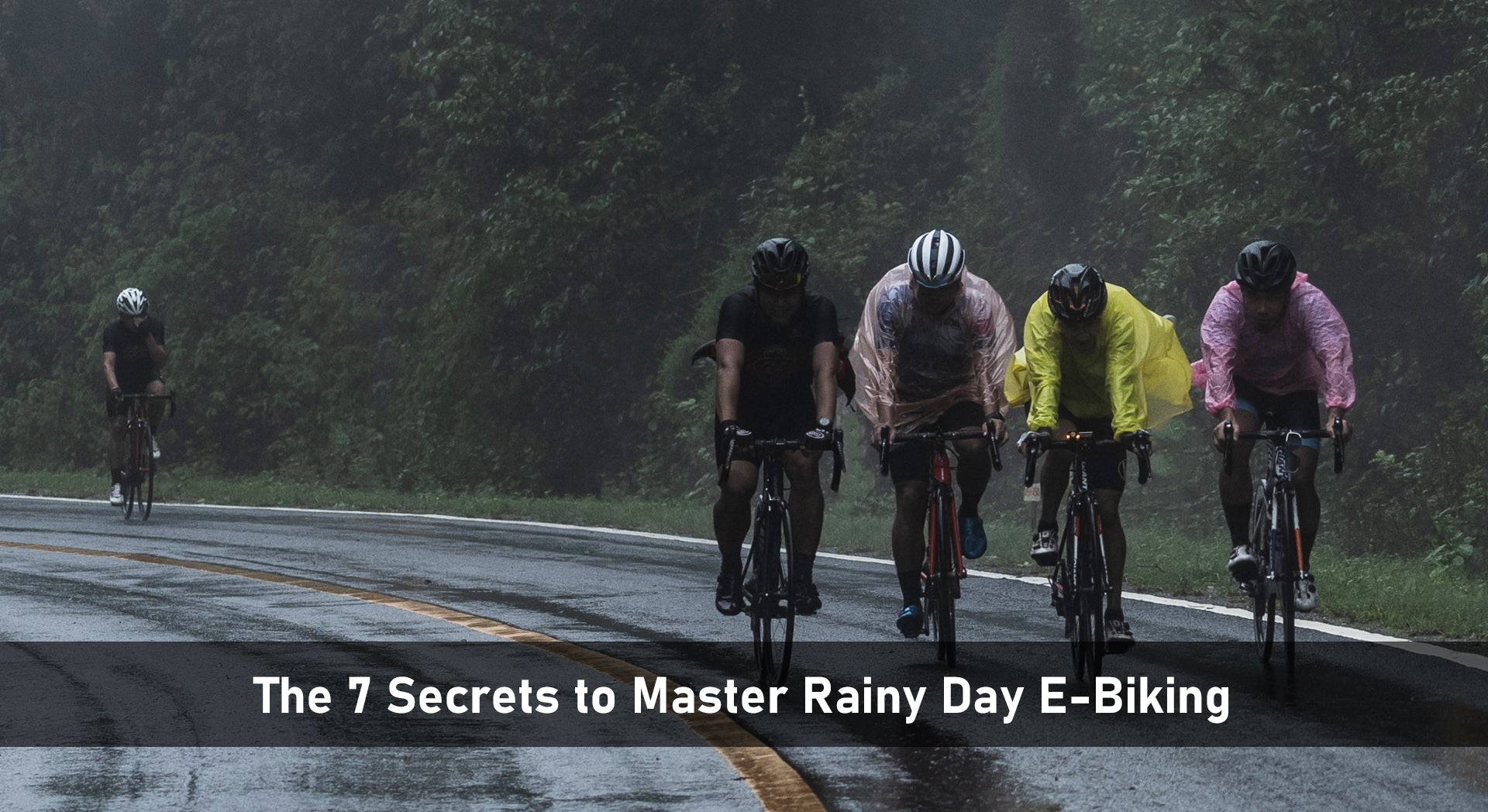In the realm of electric bikes, rainy days seem to be a deterrent for many riders. However, for those of us who have a passion for cycling, rainy weather does not hinder our pursuit of the thrill of the ride. On the contrary, as long as we possess the right gear and skills, riding in the rain is not only possible but can also become a memorable adventure. In this article, we will unveil seven secrets to overcome the challenges of riding in the rain, opening up a dance with electric bicycles under the rain. Let's together uncover these secrets and transform rain into a new friend for your electric bicycle.
Can Electric Bikes Be Used in the Rain?
Absolutely, electric bikes can indeed be used in the rain. The majority of electronic components in electric bikes are sealed and possess waterproof features. This implies that riding and parking in the rain are both permissible. However, it's crucial to note that certain types of electric bikes may not be suitable for use in humid conditions. To ensure safety, it is advisable to have a comprehensive understanding of your electric bike before embarking on a rainy ride.
Can You Ride an Electric Bike in the Rain?
The answer is YES. Even though the arrival of rain may add an extra layer of challenge to your journey, with thorough preparation, electric bikes remain a safe and efficient mode of transportation. Not only are they waterproof, but they also provide a continuous sense of security and relative comfort throughout your ride. In particular, YosePower electric bikes are manufactured according to the IP65 waterproof standard, ensuring complete peace of mind when riding or parking in the rain. However, it's advisable not to submerge it in stagnant water for extended periods, a practice to be avoided for any electrical components.
As you gear up for your next rainy ride, let's uncover the 7 secrets to overcoming rainy-day cycling together. Enhance the safety and enjoyment of your travels.
- The Necessity of Mudguards
When cycling in the rain, mudguards have proven to be an indispensable solution to the issue of mud and water splashing. Far beyond being merely an aesthetic accessory, these simple devices serve as essential tools in maintaining cleanliness on slippery surfaces and enhancing the overall cycling experience. One of the primary functions of mudguards is to reduce the splashing of mud and water on the road. Through clever design, they effectively intercept and diminish the rain, mud, and debris sprayed from the road, preventing them from projecting onto the rider and various parts of the bike.
Beyond keeping the rider relatively clean, mudguards significantly improve the comfort of cycling, eliminating the disturbance caused by mud and water and making the ride more enjoyable. Furthermore, the presence of mudguards extends the lifespan of the electric bike. It minimizes the erosion caused by rain and mud on critical components, thus enhancing the overall durability and reliability of the entire vehicle.
- The Significance of Ebike Battery Waterproof Cover
The battery of an electric bike serves as the vehicle's lifeline and becomes particularly vulnerable during rainy rides. Consequently, the importance of the battery waterproof cover cannot be overstated. This crucial accessory not only effectively prevents rainwater from infiltrating the battery, enhancing the overall stability and reliability of the entire bike, but it also shields the battery from the detrimental effects of humidity. Despite its compact size, this powerful gear not only guards against potential malfunctions and performance degradation but also elevates the overall performance of the bike in damp conditions.
During rainy rides, the battery waterproof cover emerges as an indispensable component to ensure the efficient and safe operation of the electric bike. It provides riders with a more secure and worry-free travel experience, safeguarding against potential issues and allowing for a seamless journey through wet conditions.
- Keeping Dry with Rain Gear
Rain gear plays a pivotal role in cycling during wet weather, serving not only as waterproof equipment but also as a key tool in enhancing the overall cycling experience. A full set of waterproof rain gear is essential for cycling in the rain, cleverly deflecting rain and ensuring that riders can stay relatively dry in inclement weather. Moreover, rain gear significantly improves the comfort of cycling, shielding riders from the annoyance of rainwater intrusion. When choosing rain gear, breathability is a critical factor to consider. Well-ventilated rain gear not only effectively repels water but also provides excellent airflow, preventing riders from feeling overheated and uncomfortable during the ride.
- Decelerating and Braking Early for Safety
Cycling on slippery roads necessitates the essential practices of deceleration and early braking to ensure a safe ride. These two critical maneuvers are not only fundamental skills for riders facing the challenges of rainy days but also essential means to maintain control on unpredictable road conditions. Maintaining a steady speed and exercising predictive maneuvers are particularly crucial, especially in complex environments like rainy weather. By slowing down and braking in advance, riders can effectively mitigate the risk of slipping on slippery surfaces, reducing the likelihood of accidents during the ride. Abrupt acceleration and sudden braking often lead to loss of control, making it vital to proactively address potential hazards.
- Navigating Slippery Surfaces and Puddles with Caution
Cycling in the rain introduces additional challenges with the presence of slippery surfaces and puddles. In these conditions, being cautious of smooth surfaces and avoiding areas with accumulated water becomes pivotal for maintaining cycling stability. Wet and slippery roads increase the risk of vehicles losing traction, necessitating riders to remain vigilant, especially when encountering sections with standing water. Adapting cycling techniques to wet and slippery surfaces is crucial during rainy rides. By slowing down, maintaining a stable speed, and adjusting the route, riders can effectively reduce the risk of slipping. Furthermore, steering clear of areas with standing water and opting for relatively dry paths enhances the overall safety of the ride.
- Choosing a Safe Route for Rainy-Day Cycling
When cycling in the rain, selecting a safe route is a paramount measure to ensure a secure journey. Thoughtfully planning a relatively safe route proves effective in avoiding potential hazards and enhancing overall safety during the ride. Firstly, steering clear of steep slopes is crucial, as the wet and slippery roads can make uphill and downhill travel more challenging. Opting for gentle slopes reduces the difficulty of cycling. Secondly, avoiding low-lying areas prone to water accumulation is advisable, as these locations are susceptible to forming deep puddles, introducing uncertainties in navigation. Lastly, choosing areas with well-maintained road conditions, steering clear of overly rugged or damaged sections, ensures a smooth and stable cycling experience.
- The Importance of Timely Cleaning
After cycling in the rain, promptly cleaning your electric bike becomes a crucial step in maintaining its aesthetic appeal and overall performance. The mud and dirt splashed onto the bike can lead to corrosion and damage, making regular cleaning especially important. This not only helps prevent metal rust caused by damp conditions but also removes chemicals from the mud that could harm the bike's surface, thus extending the lifespan of your electric bike. Moreover, cleaning key areas such as the wheels and brake systems not only enhances the bike's visual appeal but also contributes to maintaining optimal performance. In particular, cleaning the brake system eliminates the risk of brake failure caused by mud, providing riders with a safer and more comfortable cycling experience.
In essence, conquering the challenges of cycling in the rain relies on comprehensive preparation and careful maneuvers. Employing accessories such as mudguards, battery waterproof covers, and raincoats, coupled with adhering to principles like slowing down and navigating cautiously through the road conditions during your ride, ensures that you can still enjoy the convenience of electric biking safely and joyfully, even in wet weather.


Share:
6 Questions about E-bike Batteries
How to get the right saddle height for your bike